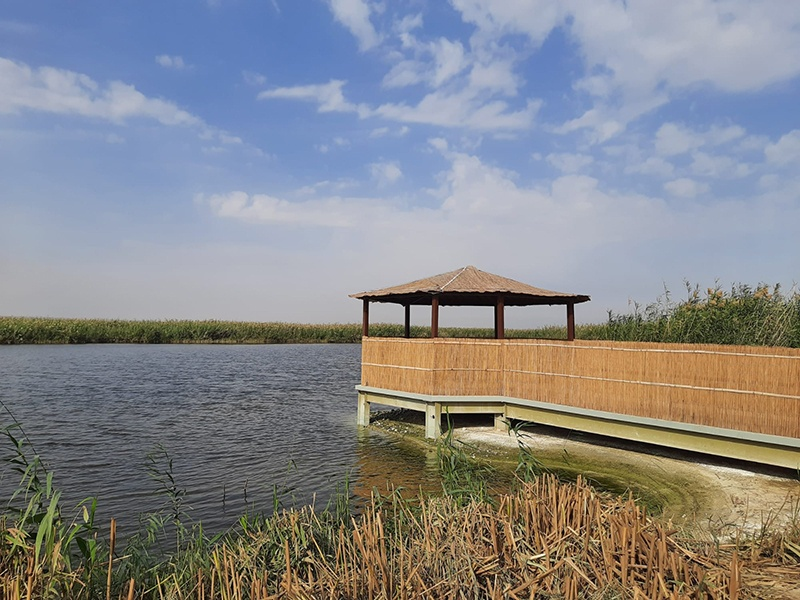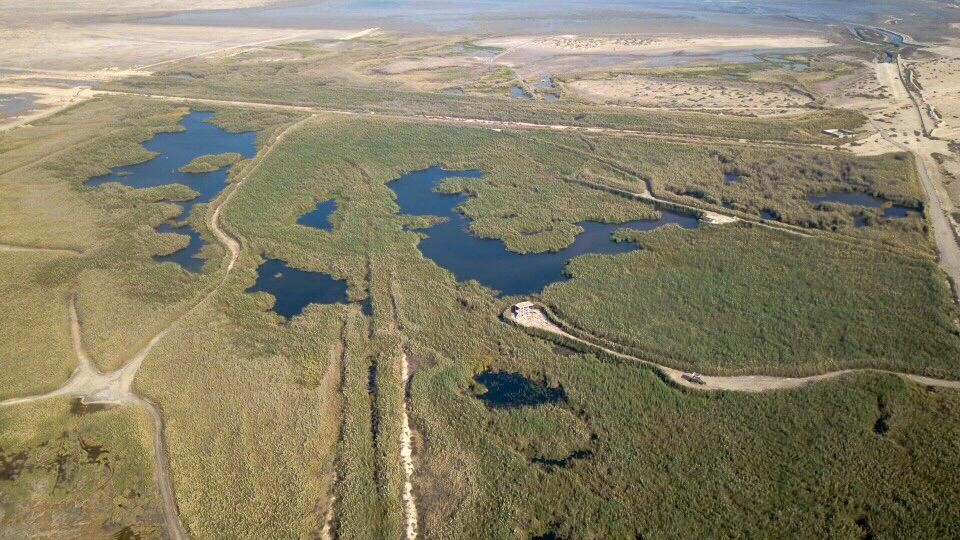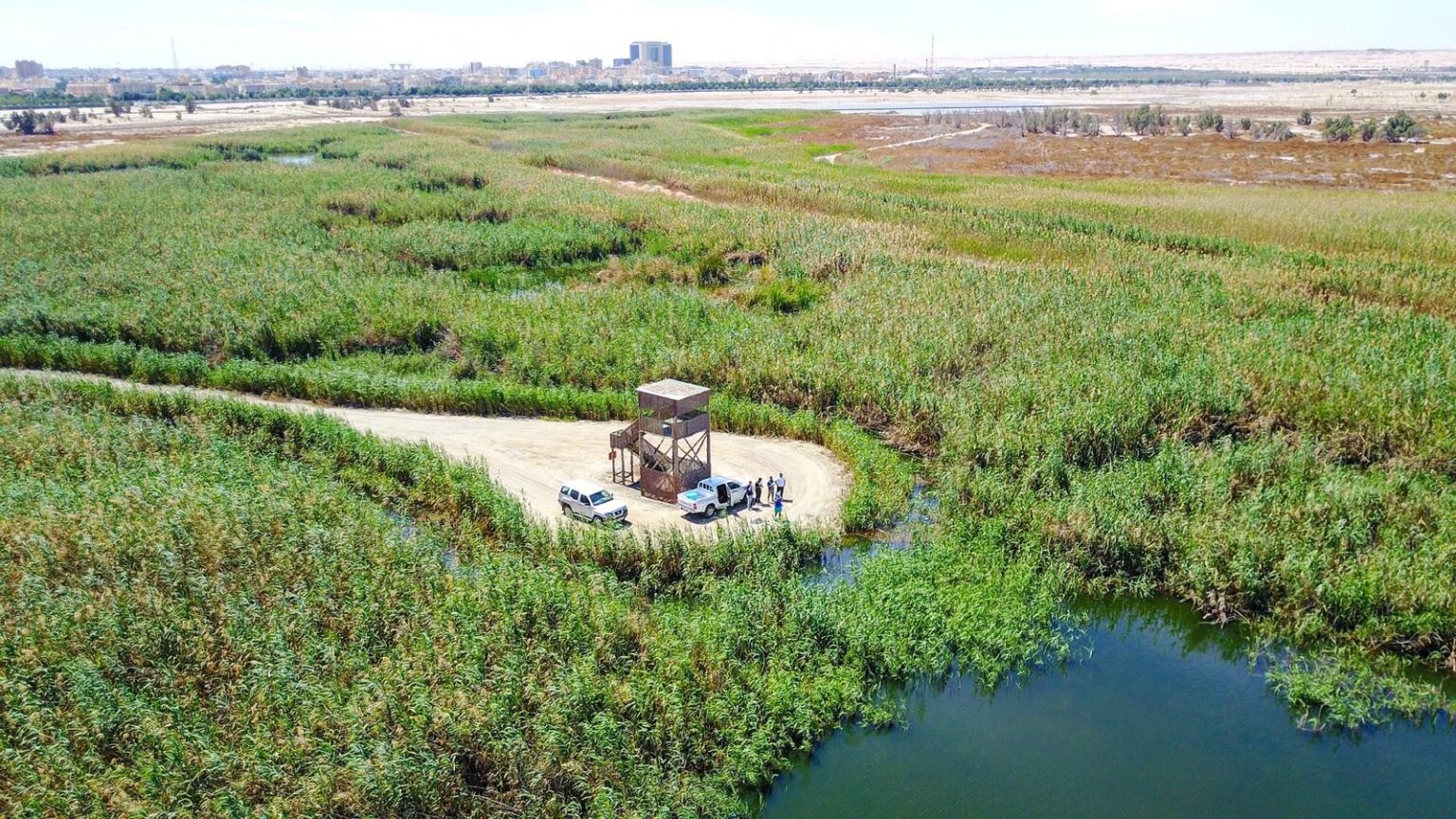Al Jahra Pools Natural Reserve is well-known for its role as a sanctuary for migratory and resident birds. With over 300 bird species recorded, the reserve acts as a critical habitat for endangered and rare species.
You’ll find flamingos, eagles, herons, and sandpipers gracefully gliding over the freshwater pools and mudflats. For birdwatchers and wildlife photographers, Al Jahra Pools Natural Reserve is one of the best spots in Kuwait.
Migratory birds from Asia, Europe, and Africa stop here during their seasonal journeys, making it a global crossroad for avian life. The diverse ecosystem also supports fish, amphibians, and desert flora, making it an all-round nature hotspot.
Rich Ecosystem and Natural Beauty
What makes Al Jahra Pools Natural Reserve truly magical is its surprising contrast to Kuwait’s usual desert environment. The presence of freshwater pools, reeds, and lush wetlands creates an oasis effect. Visitors often describe the reserve as a slice of untouched paradise.
The wetland environment, with shallow pools and muddy banks, supports rich biodiversity. You may spot small reptiles, crabs, dragonflies, and even frogs that thrive in these moist conditions.
This natural landscape is also important for preserving native plant life. Reeds, grasses, and aquatic plants naturally filter the water and provide shade and food for many species.

Why the Reserve Was Established
The Al Jahra Pools Natural Reserve was established to conserve Kuwait’s remaining wetlands and to protect its vulnerable species. It also serves as an educational site, teaching the public about the importance of conservation.
Environmental degradation and urban development have threatened the natural habitats of Kuwait. Al Jahra Pools Natural Reserve is a vital step toward reversing this damage. The protected area demonstrates Kuwait’s commitment to biodiversity, climate resilience, and sustainable tourism.
Kuwait’s Environment Public Authority (EPA) manages the reserve and continues to invest in habitat restoration, visitor facilities, and wildlife monitoring.
Best Time to Visit Al Jahra Pools Natural Reserve
The best time to visit Al Jahra Pools Natural Reserve is between October and April, when migratory birds are present in large numbers and the weather is comfortable.
Early mornings are ideal for spotting birds and enjoying the calm atmosphere. If you’re lucky, you might catch flocks of flamingos at sunrise, feeding and dancing in the shallow pools.
Avoid summer visits as the high heat makes exploration difficult and many birds migrate away during that time.
Visitor Access and Entry Guidelines
While the Al Jahra Pools Natural Reserve is open to visitors, it is not a public park. Access is regulated to protect the fragile ecosystem.
Visitors must obtain prior permission from Kuwait’s Environment Public Authority. Guided tours are available for researchers, students, and nature groups. These tours are led by trained professionals who explain the significance of the area while ensuring no disturbance to the wildlife.
Photography is allowed but flash and drone usage are restricted. Visitors are advised not to litter or touch any animals or plants within the reserve.
Facilities and Visitor Experience
Although the reserve does not feature commercial attractions, its facilities are well-suited for a peaceful nature experience. Wooden observation towers offer stunning views of the wetlands, while narrow walking trails take you through the heart of the ecosystem.
Binocular stations and eco-education panels provide insights into the biodiversity of the region. The experience is both informative and relaxing.
If you enjoy peaceful, low-impact travel with a strong focus on sustainability, the Al Jahra Pools Natural Reserve is a perfect destination.

Conservation Challenges and Efforts
Despite being protected, Al Jahra Pools Natural Reserve faces several environmental challenges. Pollution, illegal waste dumping, and climate change all threaten the fragile balance of the ecosystem.
Kuwait’s Environment Public Authority has been active in cleaning operations and environmental awareness campaigns. Restoration projects have helped improve water quality and reintroduce native plant species.
Community participation is growing, with more schools and NGOs becoming involved in conservation efforts. The reserve has also become a platform for educating the public on climate change, wetland conservation, and Eco-tourism.
Why You Should Visit Al Jahra Pools Natural Reserve
Here are 7 powerful reasons why you should plan a visit to Al Jahra Pools Natural Reserve:
- Unique Biodiversity: Discover birds and wildlife you won’t find anywhere else in Kuwait.
- Peaceful Environment: Escape the city and enjoy nature in its purest form.
- Educational Value: Learn about wetland ecosystems and conservation practices.
- Photography Opportunities: Capture rare bird species and stunning wetland views.
- Sustainable Tourism: Experience eco-friendly travel without damaging the environment.
- Cultural Significance: Connect with Kuwait’s natural history and heritage.
- Seasonal Wonders: Witness the spectacular bird migrations during winter months.
Whether you’re a student, nature lover, traveller, or conservationist, the reserve has something meaningful to offer.
How to Reach the Reserve
Al Jahra Pools Natural Reserve is located about 40 minutes by car from Kuwait City, near the northern shore of Kuwait Bay.
Visitors typically use private transportation or organised Eco-tour buses. Clear signboards direct you to the entry point, and GPS navigation is available. Since the area is restricted, ensure that you have the necessary permits and confirmations before you go.
Parking is available outside the main entrance, and basic visitor amenities are accessible.
Future of Al Jahra Pools Natural Reserve
The future of Al Jahra Pools Natural Reserve looks promising with growing interest from both local and international communities. Plans are in place to expand educational tours, improve visitor facilities, and introduce smart monitoring systems for better conservation data.
Researchers are also using the site to study the effects of climate change on wetland ecosystems. With government support and public awareness increasing, Al Jahra Pools Natural Reserve could become a leading example of sustainable eco-tourism in the Gulf region.
Conclusion
Al Jahra Pools Natural Reserve is more than just a wetland; it is a living classroom, a birdwatcher’s paradise, and a vital reminder of why we must protect nature. In a rapidly urbanising region, this hidden sanctuary offers peace, inspiration, and a rare connection to wildlife.
Whether you’re in Kuwait or planning to visit, do not miss the chance to explore this exceptional natural reserve. With every visit, you support the effort to preserve the environment for future generations.
Do follow Gulf Magazine on Instagram
Also Read – Kuwait Red Fort: 7 Powerful Reasons to Visit in 2025



